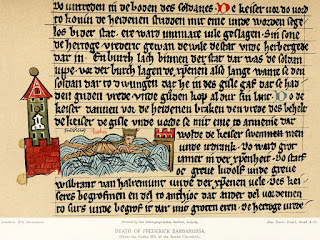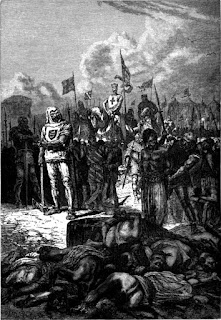Saladin had been following the forces of the Third Crusade, led by Richard I of England, down the coast of the Mediterranean toward Jaffa. Richard knew the port of Jaffa would be important to hold if he wanted support in re-taking Jerusalem. Saladin knew he needed to force a confrontation, and Arsuf was going to be the best chance to attack the Crusaders.
While the Crusaders were crossing the plain of Arsuf, Richard kept the army in a tight defensive formation against the harassing attacks, waiting for the right moment to counterattack. An account of the Third Crusade, the Itinerarium Regis Ricardi ("Itinerary of King Richard"), states that the Ayubbids outnumbered the Crusaders, 300,000 to 100,000. Those numbers are highly flawed, and realistically Saladin probably had about 25,000 soldiers, mostly mounted.
Crusader forces were estimated to be 9,000 with Richard, 7,000 French troops, and about 4,000 from other sources (local, Danes, Frisians, Genoese, etc.). On the morning of 7 September 1191, it was obvious to Richard that Saladin's forces were hiding in the Wood of Arsuf that lay ahead. He had the military orders—Knights Templar, Knights Hospitaller—at the front and rear. He wanted the ranks to stay in formation as much as possible for defense.
The Ayubbids fired arrows and made small skirmishes against the Crusaders, always pulling back to encourage the Crusaders to break ranks and follow, but the defense held. According to the Itinerarium:
In truth, our people, so few in number, were hemmed in by the multitudes of the Saracens, that they had no means of escape, if they tried; neither did they seem to have valour sufficient to withstand so many foes, nay, they were shut in, like a flock of sheep in the jaws of wolves, with nothing but the sky above, and the enemy all around them.
Unfortunately, the attacks were then made on the rear of the column, forcing the Knights Hospitaller to turn and walk backwards to stay with the main army and deal with the attacks. Saladin himself joined this part of the offense. Finally, a contingent of Knights Hospitaller broke away and charged the Ayubbids. To ensure success, Richard had to allow the army to join them, switching from defense to offense.
A note here on whether the Hospitallers acted against Richard's orders: Richard's own letters that make reference to the battle do not place blame on anyone for breaking ranks. It is possible that he allowed those at the head of each division to take initiative, and trusted the sub-leaders to know what was best in their circumstances.
Whatever the case, pitched battle began, the only time Richard and Saladin actually clashed. Tomorrow we'll see the result.

















.jpg)
